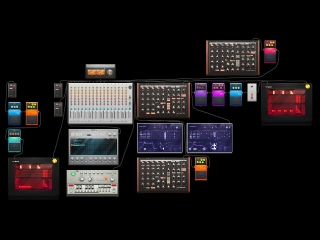

You press "Play" to hear the result, and everything sounds amazing. You sit at the mix and decide that Track A needs a bit of EQ, some compression and a hint of reverb. While we're at it let's suppose the two tracks were recorded by a top-notch, groovy, funky duo. Let's take two audio tracks: Track A has a kick and snare groove, Track B has a bass guitar riff. And this is where it can get out of hand. So how is “internal processing delay” different from “buffer size”? While buffer size is a system-wide parameter, processing delay changes dynamically with routing, plug-ins and processing chains. This is why, generally, small buffer sizes are preferred in recording (and need the smallest latency between what you play and what you can hear back from your DAW) and larger buffer sizes are preferred in mixing (when you no longer need time-critical responsiveness and prefer to use more plug-ins by relaxing the strain put on your system) Larger buffer sizes: decreased responsiveness, lower CPU/system resources usage.Smaller buffer sizes: increased responsiveness, higher CPU/system resources usage.On the other hand, larger boxes make the computer work less in a given time interval (e.g. This means that, from the time you hit “Play” to the time that first box reaches your loudspeakers, more time will pass. With a large buffer size, your computer will take it easy: a large box means lots of data can go in it, and the box will be closed and sent only when full.

Just like in real life, those boxes don’t allow much stuff in them, so you’ll need lots of boxes, lots of tape, lots of packing, lots of energy. Since the box is small, the time required to pack and ship the first box from the time you hit “Play” will be very short, but your computer will need to work more (higher CPU usage) to make sure all those tiny boxes are sent. 1 second) your computer will need to use more boxes, more energy to put stuff in them and pack them securely, then ship them to your loudspeakers. The smaller your buffer size, the smaller the boxes your computer will use to put data in to send to your loudspeakers.

Think of it as a number of boxes that travel regularly from your computer to your loudspeakers. To explain buffer size I always use the following example:Įvery time you press “Play” on your DAW, you are requesting data from your computer’s “brain” to your loudspeakers. Buffer size vs Latency Compensationįirst off, these two things are not the same. In this article we will take a look at Pro Tools way of managing its ADC (Automatic Delay Compensation) but the concepts expressed here will give you the skill-set and detective hat required to perform these checks and diagnostics on every DAW. One of the most overlooked and underestimated aspects of a DAW is its ability to handle internal delays inherent with routing and processing. The last thing anyone wanted was to see a session stall, with the artist losing precious time and inspiration, because of some technicality.Īll this is still valid today, even if those technicalities have changed, for those who make music with comptuers (Fab told me there seems to be a bunch of them, around). “Back in the days” (Scottish accent, this time), all technical elements involved a number of people who knew their way around tape machines, analog desks, outboard, lines and even real reverb chambers. Some of these are artistic, others are merely technical. Music production and record-making is a multi-faceted process where many elements play a role.


 0 kommentar(er)
0 kommentar(er)
